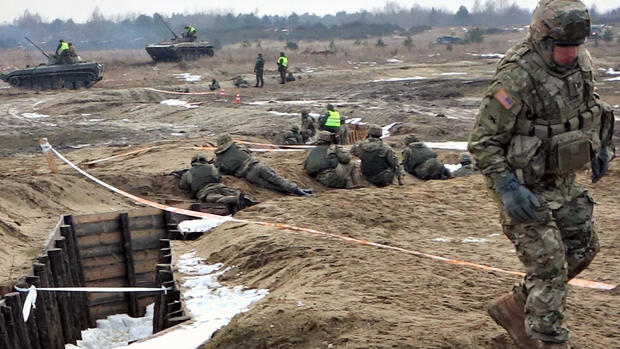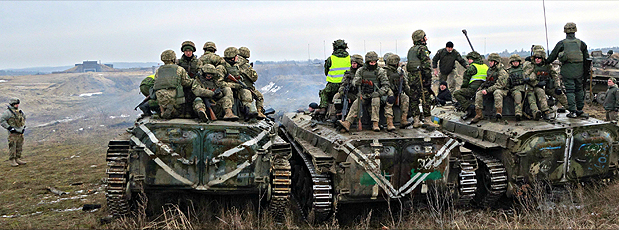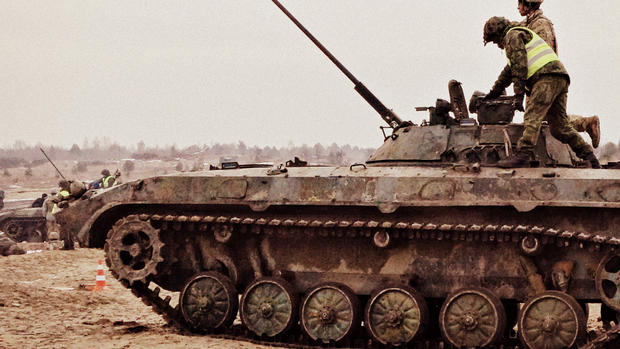"Re-tooling an army from scratch," as it fights a war
NEAR YAVORIV, Ukraine -- The U.S. and Lithuanian soldiers training a platoon of Ukrainian army soldiers on a cold, blustery day near the border with Poland were preparing the Ukrainians for their first "live fire" exercise.
But first the U.S. commander had to be certain they were ready. So after loading up in their aging Russian-built infantry fighting vehicles, with Lithuanian soldiers shouting directions down to the Ukrainian drivers in Russian -- a necessity, as it is a common language -- they rolled away over the mud and ice-covered terrain to a spot not far away, and fired blanks.
They were not yet ready.
Safety is one of the key lessons here. Some of the Ukrainian soldiers are new recruits. Others are already veterans of the frontline in eastern Ukraine, but haven't been formally trained.
The Americans and Lithuanians are adjusting their training practices, according to the Ukrainians' experience.
That included building a large trench.
"The installation basically built this huge trench network to replicate some of the conditions... out east," Capt. Evan Adams, the American operations officer who organized this exercise, told CBS News. "On our side, we really don't do a lot of 'trench' (training)."
It's a 55-day course for the Ukrainian soldiers -- the first from the Ukrainian army to train with this multi-national coalition. They will graduate in mid-February, and most will then head back to eastern Ukraine.
The U.S. is working with Canadians, British and Lithuanian forces at the remote training center near Yavoriv, which is now referred to as the Joint International Peacekeeping Security Center.
The Canadians are also training the Ukrainians, at another facility, to counter IEDs, and they'll be starting flight safety training, too. There is extensive medical training because so many Ukrainian soldiers died in the early fighting as Russian-backed rebels seized ground in the east of the country.
Canada also regularly sends teams to Kyiv to train Ukrainian military police.
Lt. Colonel Nick Ducich of the California National Guard, the U.S. commander of the Joint Multi National Training Group Ukraine, arrived in early November, when the mission turned from training Ministry of Interior troops to regular army units. Five Ukrainian Army battalions will come through this training center in the months ahead.
"The training here will increase their survivability on the battlefield," Ducich said. "They're going against an enemy that has very sophisticated weapons -- and not just from the lethal standpoint... there's an electronic warfare aspect to this that we have not seen that we are now incorporating into the training here. I don't think it's about matching (Russia's capabilities). I think it's knowing what you can do and maximizing that effectiveness on the battlefield."
"We're learning a great deal from them. Our recent history is Afghanistan and Iraq, and the Ukrainian experience is a lot different. So we're very respectful of what they need," said Lt. Col. Tim Arsenault, the commander of Canadian forces.
Anatoly, a 46-year-old Ukrainian Army Major, who has spent a year and a half fighting in the eastern battleground cities of Donetsk and Luhansk, said the Americans ask a lot of questions about the Russian weapons the Ukrainians have seen.
The most important training, he believes, centers on navigating around the battlefield and saving injured troops. In the early days of the conflict, he says, "there was a lot of blood."
The future challenge will be preparing and equipping the Ukrainian military to run the training facility on their own. But they face numerous challenges.
Anatoly, who did not want CBS News to use his surname, said weapons and equipment were frequently stolen in years past.
"Their (Ukraine's) military had not been funded traditionally until this outbreak, and now they're engaged in a fight," said Ducich. "They're modernizing their weapons and revising almost their entire approach to their military structure. All of this is going on at the same time. I think it's under-appreciated, by some, of what exactly they've had to go through; still be in this fight and be where they are right now."
"They're re-tooling an Army from scratch," added the U.S. commander.
And that process could take years.
The current U.S. training is defensive only in nature.
"What we can't tell them is how to defeat their current threat. We can show them basically how to defend what they have and to protect themselves," said Adams, who organized the drill we observed. "This stuff is very real for them."
On this particular day of training, the Ukrainians eventually successfully completed their live fire training.
"They were excellent," Capt. Adams said. "They executed a lot faster than we thought they would. The troops we're training are resilient, and resourceful. The more we teach them the more they improve. I don't doubt their abilities at all. I wish them only the best and honestly hope that our training will help them."
Filed by CBS Radio News correspondent Cami McCormick.


